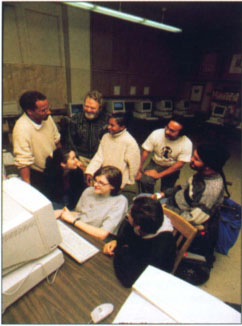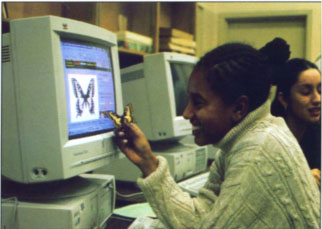All Issues
“City Bugs” website turns teens into taxonomists
Publication Information
California Agriculture 52(1):4-5.
Published January 01, 1998
PDF | Citation | Permissions
Full text
For students at McClymonds High, a tough, inner-city school in West Oakland, exploring nature with the high-tech tools of the Internet may have been a remote possibility a year ago. But today, these students do just that — with help from a team of entomologists at the College of Natural Resources (CNR) at UC Berkeley.
The scientists have created a collaborative pilot project,“Exploring Urban Biodiversity” – also known as “City Bugs” – that uses the Internet to teach urban teens about insects. The project involves the Oakland Unified School District and several UC units, including CNR's Division of Insect Biology; Cooperative Extension in UC's Division of Agriculture and Natural Resources; and UC's Interactive University program. And some neighborhood bugs.
Since City Bugs got started in the summer of 1997, 10th-grade McClymonds students have been learning how to catch, identify and mount insects. The specimens are then photographed and the images digitized for inclusion in the City Bugs website, the project's centerpiece. Generated collaboratively by students and staff, the website includes three components: an online field guide, including 4,300 entries for 740 insect groups (modeled on the book California insects by CNR entomologist emeritus Jerry Powell); a “Virtual Bug Collection,” where students enter information about specimens they've collected; and portfolios of student achievement that highlight individual contributions to the website.
McClymonds students and UC entomologists view the “City Bugs” website in the Interactive University Lab at McClymonds High School.
The students are working on the website on 16 personal computers purchased for this and other projects of UC's Interactive University (IU) underway at McClymonds. In the school's IU Lab, students are entering taxonomic information, along with their names as contributors, and receiving credit for the work in their biology classes.
City Bugs is administered by an advisory committee including several CNR faculty, students and staff. Vernard Lewis is a CNR graduate and UC Cooperative Extension (UCCE) entomologist who specializes in termite control. Eddie Dunbar, who manages the project's day-to-day operations and works for both Cooperative Extension and Interactive University, has taught entomology in local outreach programs.
Felix Sperling, an assistant professor of insect evolutionary biology, conceived the idea for the project. Other participants include Don Dahlsten, the project administrator and professor of insect biology, and graduate student Steve Suoja, who along with Dunbar operates Cooperative Extension's Insect Hotline.
Lewis, a onetime McClymonds tutor, knew from the start of City Bugs that to capture the McClymonds students' imagination he would first have to capture their attention. This was no easy task, considering the distractions – including poverty and violence – that face these youngsters on a regular basis.
“If you can reach students at McClymonds, you can reach students anywhere,” he says, only half joking. He recalls their thrown pencils and catcalls during his fall “bug show,” at which he dumped 2 pounds of bug parts on the floor and compared job prospects in entomology with those in professional sports. (“It's entertainment with the science sneaked in,” Lewis says.)
Since then, he and Dunbar have returned to the school to work on the project in collaboration with biology teacher Joe Pinador and his students. After a slow start, City Bugs has gained momentum, Lewis says, and student committees have formed to divide up the insect-collecting and website chores.
“These kids have amazing potential,” he says. “One has kept her own bug collection since she was 5 years old. Another has 17 snakes and knows the scientific name of every one.” Surveys show the students are grasping and retaining the entomological concepts they are being taught, he adds.
City Bugs is one of five UC Interactive University projects at McClymonds. IU aims to assess the Internet and Internet technology as tools for outreach, to serve as a model for outreach and to stimulate collaboration among UC researchers and between UC and public schools. Others using the website include students and teachers at other schools, as well as pest control operators.
City Bugs, in particular, is designed to introduce students to biodiversity and inspire them to study natural sciences at the college level. The Berkeley team is particularly well suited to inspire McClymonds' diverse population: Lewis is African-American, Dunbar is Japanese and African-American and Suoja is disabled.
Chris Ashley, the Oakland Unified School District project liaison for Interactive University, says the McClymonds 10th-graders” are actually making a picture of insect life in their own neighborhood. That's real research that will be useful to other students, teachers and researchers.”
He continues, “I think that connections with educators outside of our school is a very important contact for our students. Especially when working with urban populations, a student's ability to identify with university researchers and to identify themselves as university material is a powerful and important change in point of view and outlook.”
An example is Dunbar himself. A graduate of the Oakland District's Fremont High School, he was inspired to become an entomologist at age 12 after meeting CNR's Dahlsten.
Besides inspiring students, City Bugs can serve as a teaching and learning model for other educational programs using the Internet. The City Bugs website can be found at http://www.cnr.berkeley.edu/explore UC's Interactive University web address is http://iu.berkeley.edu/iu/






